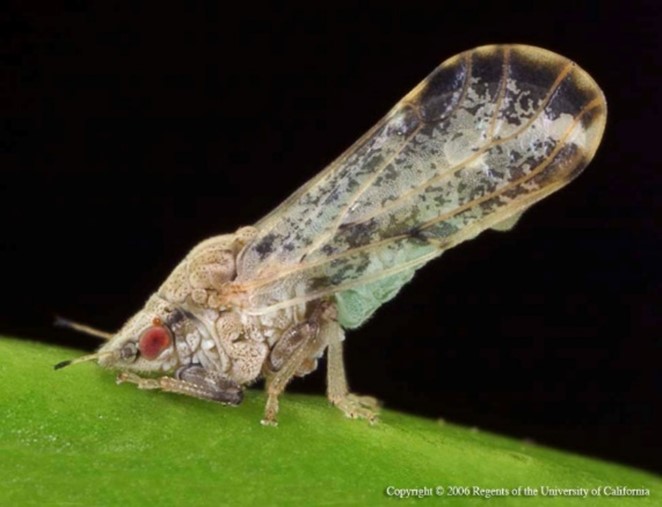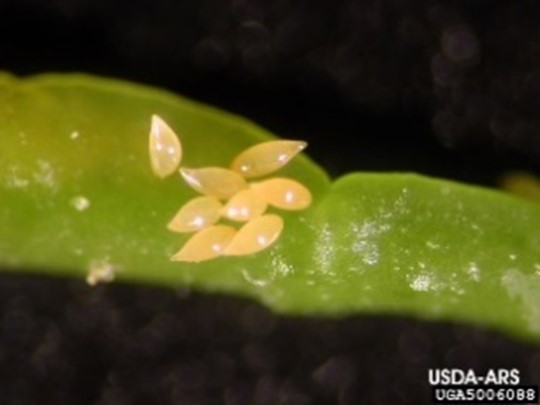Asian citrus psyllid
An exotic pest – not wanted in Australia
Asian citrus psyllid (Diaphorina citri) poses a serious threat to backyard citrus and the citrus industry.
Keeping Asian citrus psyllid out of the country is a national priority.
Have you seen this pest?
- Adults are 2–4 mm long (Figure 1).
- Flat yellow-orange coloured nymphs produce sticky honeydew.
- Sucks saps from wild and cultivated citrus trees.
- Feeds on young leaves and shoots of citrus trees.

What should I do?
- Report it immediately.
- Share your photos with us using the online public reporting form
- Call the Exotic Plant Pest Hotline 1800 084 881
- Please take good-quality photos of the pest and/or damage to include in your report. For tips, see the How to take good photos for a report guide.
Why is it a pest of concern?
Asian citrus psyllid is an exotic sap-sucking pest of wild and cultivated plants in the citrus family.
Feeding by the pest stunts the growth of young plants by stopping shoot growth and causing leaf deformation. Heavy populations cause blossom and fruit drop. Black sooty mould can develop from excess honeydew excreted by the psyllid whilst feeding.
Asian citrus psyllid can transmit the high-priority bacterium that causes huanglongbing (HLB), also known as citrus greening, from tree to tree via feeding.
HLB causes yellowing of leaves with a blotchy mottled pattern. Trees lose their leaves and show extensive twig and limb dieback. Fruit produced is small, lopsided, unevenly coloured and bitter tasting. Eventually, the tree stops bearing fruit and dies. HLB can kill a tree within 5 years, and all commonly grown citrus varieties are vulnerable.
Where to look
Adults and nymphs are found on young leaves and shoots of citrus plants when the plant is in vegetative flush, and flowering and fruiting stages.
Adults feed on the underside of young leaves with their head down and the rest of their body raised in the air at a 45-degree angle (Figures 1 & 2).
Nymphs are flat and oval shaped, yellow-orange in colour with bright red eyes. There are 5 moulting stages, all of which can be present on the tree at one time (Figure 3).
Eggs are laid on tips of growing shoots and on and between unfurled leaves (Figure 4).
Waxy tubules with a bulbous end can be seen on young leaves, which are the honeydew excreted as part of the feeding process (Figure 5). Honeydew makes the plant sticky to touch.




Pest profile
Appearance
- Adults: Measure between 2 mm and 4 mm long with mottled brown bodies and light brown heads. Wings are translucent with white and light brown spots. Males are smaller than females (Figure 1).
- Nymphs (juveniles): Flat and oval shaped, yellow–orange in colour with bright red eyes, They undergo 5 moutlring stages, ranging in size from 0.3 mm to 1.7 mm, before becoming adults (Figure 3).
- Eggs: Pale when newly laid, turning yellow then bright orange before hatching. They are elongated and almond-shaped, and around 0.3 mm long (Figure 4).
Host plants in Australia
Asian citrus psyllid largely infects plants in the citrus family, with a preference for grapefruit, lemons and limes. Also at risk are native Australian citrus such as finger limes and desert limes.
Life cycle
- The life cycle from egg to adult takes as little as 14 days in warm weather (30 ºC) but extends as the weather gets colder, up to 50 days at around 15 ºC.
- Adults typically live one to 2 months and can remain overwintering in citrus tree canopies in the colder months. There are multiple overlapping generations per year.
Distribution and dispersal
- Originally from eastern Asia and has spread widely throughout Asia and the Americas. Is also present in Africa.
- Weak flyers but can be dispersed over long distances by strong winds. There is danger of dispersal from Papua New Guinea across the Torres Strait onto mainland Australia.
- Adults, nymphs and eggs can be introduced on imported host budwood, grafted trees or rootstock from infected areas.
- Infested fruit can be bought into Australia in tourist luggage.
Prevention
- Be vigilant when transporting plants to prevent the introduction of psyllids.
- Monitor imported host plants carefully to prevent the spread of the pest.
Image credits
- Figure 1: Copyright 2006 University of Florida.
- Figures 2, 3 and 4: David Hall (USDA Agricultural Research Service, Bugwood.org).
- Figure 5: USDA Animal and Plant Health Inspection Service (APHIS).
Reporting an unusual plant insect pest or disease
Report any unusual plant pest or disease immediately using our online reporting form or by calling the Exotic Plant Pest Hotline on 1800 084 881. Early reporting increases the chance of effective control and eradication.
Please take multiple good quality photos of the pests or damage to include in your report where possible, as this is essential for rapid pest and disease diagnosis and response.
Your report will be responded to by an experienced staff member, who may seek more information about the detection and explain next steps.
Report online